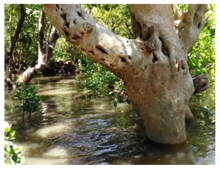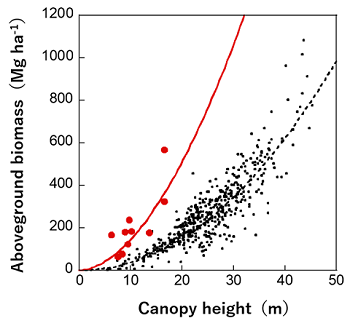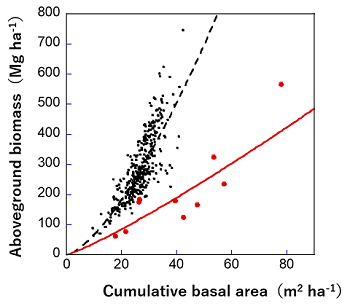Development of models for estimating mangrove aboveground biomass at regional scale
Description
Mangroves are unique ecosystems developed in brackish water areas where plants are exposed to physiologically stressful conditions such as high-salinity and anaerobic environments (Fig. 1). Recently, the huge amount of carbon stocks in mangroves have been the focus of studies due to its relevance to climate change, and mangroves have been recognized as very important for storage of blue carbon, which is carbon sequestrated in marine ecosystems. To evaluate the ability of mangroves to sequestrate carbon, biomass estimation over wide regions is essential. In general, biomass estimation is conducted with remote sensing techniques, such as the airborne Light Detection and Ranging (LiDAR) system, to measure average canopy height, which is then converted to biomass using models developed by field researchers. However, models for converting canopy height to biomass were scarce for mangroves in Southeast Asian regions. Therefore, we developed a mangrove model for Asian regions based on field studies conducted at mangroves in the Philippines, Indonesia, and Japan.Our results confirmed that the relationships of aboveground biomass (AGB) to average canopy height for upper-canopy trees showed apparent differences between terrestrial tropical forests and mangroves, where mangroves showed approximately four times higher AGB specific to the canopy height than that of terrestrial forests (Fig. 2). On the other hand, the cumulative basal area BA was approximately two times higher in mangroves than in terrestrial forests (Fig. 3). Thus, the high AGB specific to canopy height can be partly explained by their unique characteristics having higher tree density of thick stem trees. Finally, we successfully proposed a common mangrove model for Asian regions as Y = 2.25X1.81 (R2 = 0.66), where Y and X are AGB in Mg ha–1 and the average canopy height in m, respectively.
The developed model for estimating AGB with canopy height can be applied for evaluating the carbon stock of mangroves in Asian regions with remote sensing techniques. It should be noted, however, that the developed model cannot be applied to open-canopy mangroves. Furthermore, the developed model tends to underestimate AGB for large forests whose AGB > ca. 400 Mg t ha–1.
Figure, table
-
Fig. 1. Mangroves inundated with brackish water
Photo taken at a study site in the Philippines
-
Fig. 2 Relationships of aboveground biomass to canopy height
Red dots and black dots mean mangroves and terrestrial forests, respectively. The solid red line and dashed black line mean regression models for mangroves (the present study) and terrestrial forests (Saatchi et al. 2011 in PNAS).
-
Fig. 3. Relationships of aboveground biomass to cumulative basal area
Red dots and black dots mean mangroves and terrestrial forests, respectively. The solid red line and dashed black line mean regression models for mangroves (the present study) and terrestrial forests (Mitchard et al. 2014 in Global Ecol. Biogeogr.).
- Affiliation
-
Japan International Research Center for Agricultural Sciences Forestry Division
- Classification
-
Research
- Program name
- Term of research
-
FY2020(FY2018~FY2020)
- Responsible researcher
-
Suwa Rempei ( Forestry Division )
ORCID ID0000-0003-4401-5581KAKEN Researcher No.: 40535986ROLLON RENE ( University of the Philippines )
ALBANO M. G. GIANNNINA ( University of the Philippines )
BLANCO C. ARIEL ( University of the Philippines )
SHARMA SAHADEV ( University of Malaya )
YOSHIKAI MASAYA ( Tokyo Institute of Technology )
NADAOKA KAZUO ( Tokyo Institute of Technology )
KAKEN Researcher No.: 70164481ADI S. NOVI ( Ministry of Marine Affairs and Fisheries, Indonesia )
ATI N. A. RETSU ( Ministry of Marine Affairs and Fisheries, Indonesia )
KUSUMANINGTYAS A. MARISKA ( Ministry of Marine Affairs and Fisheries, Indonesia )
KEPEL L. TERRY ( Ministry of Marine Affairs and Fisheries, Indonesia )
MALIAO J. RONALD ( Aklan State University )
PRIMAVERA-TIROL H. YASMIN ( Aklan State University )
- ほか
- Publication, etc.
-
Suwa et al. (2020). Estuarine, Coastal and Shelf Science.https://doi.org/10.1016/j.ecss.2020.106937
- Japanese PDF
-
2020_C08_A4_ja.pdf417.88 KB
2020_C08_A3_ja.pdf417.64 KB
- English PDF
-
2020_C08_A4_en.pdf423.36 KB
2020_C08_A3_en.pdf424.36 KB
- Poster PDF
-
2020_C08_poster.pdf271.76 KB
* Affiliation at the time of implementation of the study.



